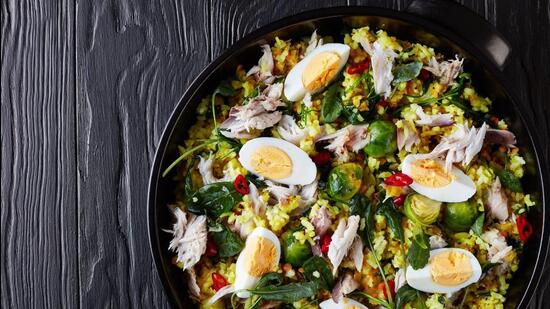Review: Chillies, Chhana, Rasa – Heritage Foods of Bengal by Nina M Furstenau
The book contains a comprehensive study of traditional Bengali culinary culture and the ways in which this was affected by overseas commerce, such as the beginning of American trade in India
A search for her roots brings food historian Nina Mukherjee Furstenau to Bengal, and what better way can there be to do so but through its food? In Kolkata she rediscovers the ‘melting pot’ of cultures that gives the city its specific identity. The collection of recipes gathered from the author’s family and friends bears evidence to this, since it includes not only traditional Bengali recipes from Bengal and Bangladesh such as kosha mangsho, machher kalia, chingri pithey, mango chutney and patishapta but also colonial foods like tipsy pudding and fish veronique from Chef Peter Gomez of Calcutta Club, together with the author’s own version of it, which is an improvement because she uses real custard instead of custard powder. There’s also Tangra Chinese chilli chicken from Monica Liu, Anglo-Indian chicken jhalfrezi and fish molee from Bomty Iyengar, aloo makallah and hilbeh sauce from Flower Silliman and many more to satiate the connoisseur’s palate.


As the name suggests, the book diligently records the plants, vegetables and fruits that have travelled around the world together with human beings and sunk roots into alien cultures even more than their procurers from distant lands. Much has been written about these journeys and settlements but what sets this particular book apart is the sense of wonder that accompanies the detailed account, which is refreshing for those who are familiar with the history. In her research into certain essential foods of Bengal, such as milk, grains, limes and chillies, she sometimes challenges accepted data, asserting for instance that chhana was not unknown to India before the Portuguese. She cites evidence from Manasollasa, written by King Somesvara III of the Chalukya dynasty (1126 – 38) in which, among other foods, there is mention of a sweet Bengalis would call chhana makha or kancha golla. However, I found some difficulty, as I always do, in the interchange of ‘yoghurt’ for ‘curd’. The two are actually quite different. Curd (doi or dahi) is made by curdling milk with edible acids whereas yoghurt is made by fermenting milk with bacteria. The two have different consistencies though they may be similar in taste: yoghurt is a little gelatinous, curd is firm. I was also left a little confused by the author’s description of the method of making ghee.

Having grown up in a household where ghee was regularly made, it came as a surprise to me that ghee should be made from fermented milk. To make ghee at home cream that forms on top of cooling milk is skimmed off and stored in a jar in a cool place to prevent fermentation as much as possible. When there is enough cream or shor it is whisked to smoothness and solidity, cold water added to separate the butter which forms, which is boiled to transparency till the residue settles at the bottom.

The book contains a comprehensive study of traditional Indian culinary culture and the ways in which this was affected by overseas trade and commerce, such as the beginning of American trade in India (1784 -1812), which led to the import of foreign agricultural produce which lost their native identities over time and became essential items in Indian as well as colonial cuisine. The commonest are the potato, tomato and chilli, yielding a presence in most Indian curries as well as hybrid ones.
The native bias against British taste buds is something many will share: there is some fun poked at the colonisers who kept up their meat-eating habit in tropical India and suffered from dyspepsia and other embarrassing stomach issues. Colonisation also led to the transformation and gentrification of some simple foods - khichuri as kedgeree became a breakfast dish in colonial India; the etymological mutation of the word, ‘curry’ from the Portuguese mispronunciation of the Tamil kari, became carel and then the British ‘curry’, and was ‘a blander version of the fresh spices of India … ‘curry powder’, which the British ‘sent around the world.’

Gentrification of simple foods is clearly also a matter of social class. Shireen Maswood’s recipe of panta bhat (Chapter 3) is a case in point. The humble man’s staple made from fermented parboiled rice, to be eaten cold with salt, lime wedges, onion and chillies has undergone this process. This is a gourmet recipe and a misnomer, too: The rice is basmati, fresh not fermented, cooked in butter, and the lime is gondhoraj. It is obviously eaten warm. This preparation could be called gondhoraj rice, perhaps? The term, panta, refers to stale rice. What is more, gondhoraj lebu, the empress of limes, has a flavour that goes with certain kinds of food. Its random use might alter the authentic taste of a preparation; it is also not as juicy as ordinary lime, pati lebu, which is the best seasoning for street food like phuchka, aloo kabli and rolls. It is not customary to use gondhoraj in place of lime in these.

Mukherjee Furstenau’s language is what makes the book an engaging read. The fund of information is delivered in an easy, conversational style which retains the reader’s interest.
Indranee Ghosh is the author of Spiced, Smoked, Pickled, Preserved; Recipes and Reminiscences from India’s Eastern Hills.
Continue reading with HT Premium Subscription




